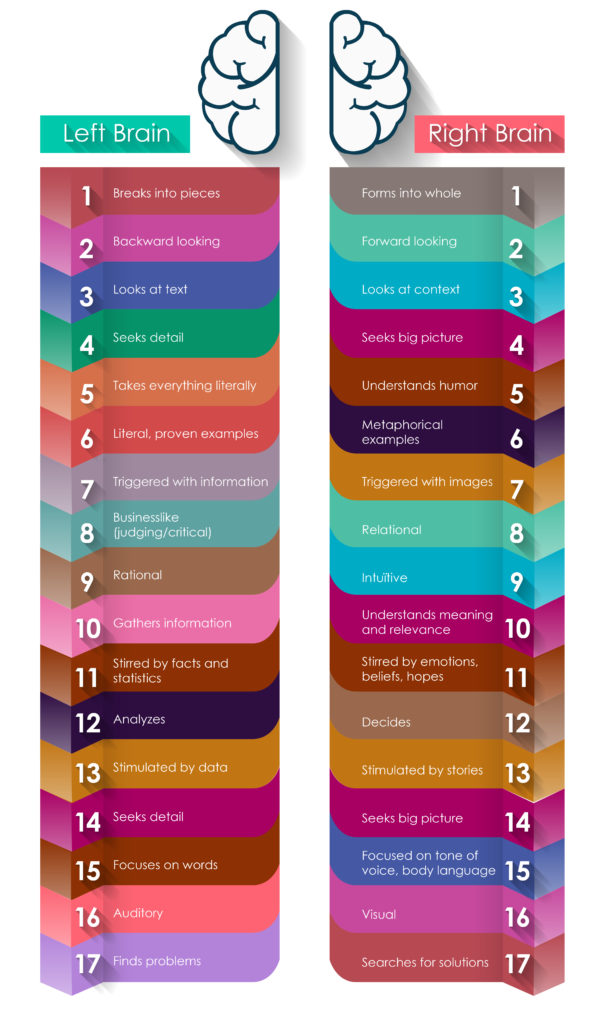Let me ask you a question first.
Why do you think people buy your service?
Many people believe that buying decisions are fairly logical. Your prospect adds up the cost and benefits of your service, compares it with others, and chooses the service with the better score.
We like to think that a client’s decisions are conscious and deliberate. Although certainly there are rational components to many of your client’s decisions and actions, there’s another force that makes things happen.
The Curious Case of Visa vs. American Express
I’m going to be straightforward with you: this is a long article. That’s why I’m sharing an intriguing story with you first so that you can decide if it’s interesting enough to continue reading.
Here goes.
Let’s consider these stats:
- Visa cards are accepted in almost three times as many locations than American Express cards
- You can pay back a Visa Card immediately or over time. You must pay on American Express card at the end of each month (or suffer substantial penalties)
- You pay $20 for a basic Visa Card, and $55 for one from American Express

Now, what truly rational people want from a credit card is utility relative to price. If they are being logical, they want to be able to use the card wherever and whenever they buy and have the option to pay their balance immediately. Truly rational people also want to pay as little as possible for those benefits.
A truly rational person, in other words, chooses a Visa card. Perhaps all of earth’s rational people choose Visa cards.
But that leaves approximately 25 million Americans who use American Express cards.
So, what’s their magic trick?
Prestige.
American Express emphasizes that “membership has its privileges”, and that privilege of membership is in being part of an “elite” club.
An enormous “elite”- 25 million people – by the way.
Logical?
No.
However, those American Express cardholders are prospects for your service too!
And few prospects for your financial planning service can intelligently evaluate the rational features of your service and make an informed, rational choice.
Your prospects feel like the jurors in a court case. Befuddled by the facts and often mistrustful of the parties offering those facts, these jurors look beyond the facts, to things like the shine of the defendant’s shoes, the niceness of the defendant’s attorney, and a dozen other seemingly irrelevant details.
If you appeal only to a client’s reason you may have no appeal at all
And I hear you think: “What does work?”
I’ll tell you in a minute. Let’s hear what the experts have to say first. Science tells us that researchers are constantly exposing new ways in which our subconscious mind, drives our choices, often with minimal conscious involvement.
Yes, it turns out that our conscious minds are not in charge of what we do. It’s our subconscious mind that’s making most of the decisions.
As it turns out, our subconscious mind is in charge of 95%(!) of our decisions.
The best book on this subject is probably Predictably Irrational, Revised and Expanded Edition: The Hidden Forces That Shape Our Decisions by Dan Ariely. Ariely refutes the common assumption that we behave in fundamentally rational ways. In fact, we behave in irrational ways. And Ariely’s research shows us that we even behave predictably irrational.
Another great book on this subject is written by Harvard marketing professor Gerald Zaltman in How Customers Think: Essential Insights into the Mind of the Market. It’s about the fact that 95% of our thoughts, emotions, and learning occur without our conscious awareness.
Zaltman is not the only expert who thinks this way. The 95% rule is used by many neuroscientists to estimate subconscious brain activity.
In The Buying Brain: Secrets for Selling to the Subconscious Mind, A.K. Pradeep, estimates it even as high as 99.99%.
Despite the overwhelming evidence that rational, conscious cognitive processes are a small influence on human decision making, most financial planners naturally focus most of their messages on that narrow slice of our client’s thinking.
We provide statistics, feature lists, analysis, reports and so on while ignoring the vast emotional subconscious activity which controls 95% of our client’s decision-making.
Although there are conscious and rational parts in most decisions, I believe most financial planners need to focus first on appealing to their client’s right-brain and subconscious needs and wants. It’s not bad to include factual details, as they will help the client’s left-brain justify the decision. Just don’t expect them to help make the sale, feel engaged or help them trust you.
It’s not bad to include factual details, as they will help the client’s left-brain justify the decision. Just don’t expect them to help hire you for your services, feel engaged or help them trust you.
Do you want to know how to start, grow and market your financial planning service? We'll cover how to enhance your conversational skills, online marketing, how to get clients, emotional intelligence, and more.Yes, I want to engage people
Here are 3 Steps To Appeal to Your Client’s Subconscious Brain
Step 1: Understand the Differences between Left and Right Brain
The classic mistake we make in appealing to our client’s subconscious mind is trying to evoke right-brain responses (action, risk, decision) by using left-brain stimuli (numbers, facts, history).
This is equal to asking individuals to look into their future by using a microscope – they can’t see past their noses. To look into the future, requires a telescope.
So what about those left and right brain views of the world? Please take a look at this picture and notice the differences.
Step 2: Learn to Speak the Language of the Right Brain
People are more likely to buy, and continue to buy from you, when they’ve made an emotional connection to you. And remember, clients WANT to buy from you. People don’t come to you for small talk. They aren’t at your office for no reason.
Here’s how you make them feel engaged and speak the Right-Brain-Language:
Your WHY
As we all know Steve Jobs was a brilliant marketer. He knew that people don’t buy what you do, they buy why you do it. He knew that if he told the world what he was selling, he wouldn’t be compelling or different to any other computer company.
Unfortunately, that’s how most financial planners communicate. They say for example:
“I’m a financial planner, I give advice to high net worth people so that they can reach their financial goals. I’m a fee-only CFP with specialization in wealth management. Wanna buy my service?”
Compelling?
No way.
However, what would happen if you started communicating like Apple? If you start your message, your client conversation, your marketing with Your Why?
Context
Like the archaeologist who discovers a shard and immediately begins to visualize the entire ancient pot, the brain searches for the personal significance of the ideas or suggestions it hears.
If context is not established up front, your client will start questioning (internally) the relevance of your service. Asking questions is great for establishing context.
The Big Picture
Most financial planners do well in this area. They do it by talking about their client’s situation. The right side of the brain wants to know their service fits into the overall strategy.
Humor
Ponder this psychological fact: laughter and stress cannot occupy the same space at the same time. Most decisions are stressful to make. Laughter diffuses stress. Humor puts matters into their proper perspective.
Images
If a good picture is worth a thousand words, then a few good pictures could save you a lot of time and talk. I don’t refer exclusively to printed images but to images in the mind as well.
Visual stimulation
The pencil may be your most powerful selling tool. If you know how to use it, that is. A financial planner who knows how to integrate the drawing of images and outlining of ideas into his or her service, is like a teacher before a captive class.
Emotional affirmation
No question is as important as “How do you feel about this?”
Why?
Because emotion precedes logic when we hear others’ ideas. As mentioned, the choices we make are based on about 95% emotion and 5% logic.
Affirmation of values
All people have a very idiosyncratic set of beliefs, principles, or values that they try to follow when making financial decisions. It’s advantageous to discover what those principles or values are before you begin promoting your advice or ideas that may or may not match a client’s particular set of values.
Metaphors
Warren Buffett was once asked about investing in a bull market. His answer: “A rising tide lifts all boats. It’s not until the tide goes out that you realize who’s swimming naked.”
Need I say more?
Stories
People love a good story and they love to hear it told well. When you say, “Let me tell you a story….,” the right side of the brain, as well as the left side, is at full alert. You have the complete resources of the brain focused on what is to come next.
A comfortable feeling about you
Trust.
This is at the heart of the client-financial planner relationship. People seek to do business with individuals they have a good feeling about. The right side of the brain, where risk and decision are launched, is not looking at your credentials; it is observing your body language. It is not caught up in your impressive recitation of facts and figures, it is reading between the lines.
The right side of the brain is putting together what it observes in your eyes, your mannerisms, your tone and demeanor and is going to render an intuitive verdict that clients will follow even without a logical reason.
“I just have a feeling,” people will tell you – and they usually follow that feeling or are haunted by ignoring its ominous voice. Something I’ve experienced myself with one my best clients a couple of years ago.
To sum it up it’s the emotional connection to YOU that connects them to something real and alive in themselves. What I’m saying here is that when your client feels that right kind of emotional connection to you, they actually have an experience themselves that’s different to when they walked into your office.
And that’s what they really looking for.
Your clients want a connection with you because it brings something real and alive in them.
Do you want to know how to CONNECT with your ideal prospects for your financial plannning service? Yes, I want 100+ prospects
Step 3: Get Your Clients to ACT
It doesn’t seem to matter what sort of decision we are making – a purchase, a career or a negotiation – we all instinctively rely on our subconscious mind for guidance. Logic and rationale, although held in the highest esteem in our society, are not the trusted linchpins of our most important decisions. In fact, we almost always (remember the 95%) seem to make decisions based on our subconscious mind and then align the necessary logic behind that feeling.
The subconscious mind is the engine of the decision train, and logic and rationale are the cars it pulls behind
But what’s actually feeding the subconscious mind? What type of fuel is driving the decision train?
It’s what I call the mental triggers.
These mental triggers have roots that go back thousands of years, and they are present in all of us to varying degrees. And unless there is a fundamental change in the way the human mind (which is highly unlikely), these triggers will continue to exert massive influence over our actions. Hit these triggers over and over in your service, and you can almost create a sort of hypnotic spell over your prospects.
The best book by far on this subject is Influence: The Psychology of Persuasion, Revised Edition, by persuasion-professor Robert Cialdini. It’s one of the best books I’ve ever read.
Authority
People tend to follow others in positions of authority. Think about doctors in their white coats. For most of us, as soon as we see that white coat walk into the examination room, a certain part of our brain becomes completely numb. We listen to what the doctor has to say and follow his advice without thinking.
We probably feel at least a little intimidated to disagree with anything the person in that white coat says.
This isn’t unusual. Your clients often look for people to help them guide their decisions. The authority trigger helps your clients shortcut the decision-making process.
And I hear you think: how can people see me as an authority if trust in the financial industry is at an all-time low?
Well, have you ever thought about how people might see YOU instead of the industry?
Reciprocity
Reciprocity is the idea that if someone gives something to us, we will feel some obligation to give them something back in return. This is a very important mental trigger and again it’s something that goes back thousands of years.
In fact, reciprocity is the very basis from which humans were able to create commerce and trade. For trade to occur, there has to be some amount of trust that when – for example – we give a piece of advice to someone for free, they will complete the trade by “holding up their end” of the agreement.
Trust
Building trust is the ultimate short circuit to becoming influential in your client’s life. I’m sure you can think of many times when a trusted friend, parent or teacher told you something that you believed without question because of your relationship with that person.
One of the easiest ways to create trust is through time. You can probably think of a time when you had a neighbor who seemed a bit different or strange. You didn’t consider them to be a friend and probably didn’t even know them all that well. But after you lived next to them for a period of time, and after they proved themselves to be reliable and honest, you developed a sense of trust in them.
Anticipation
Think back to when you were a child and you looked forward to some special day. Maybe it was your birthday. Maybe it was Christmas morning. Time seemed to slow down as the big, anticipated day approached. It was all you could think about. You couldn’t wait for that day.
So, you might think you don’t have that anymore?
Don’t let your left-brain fool you. All of us are really just big kids. We haven’t gotten over anticipation for those special days.
Likeability
This is something almost everyone has experienced in his life. Your clients enjoy doing business with anybody they know, like and trust. Your clients are more influenced by advisors they like than those they don’t like.
So, how do you become more likable? At the risk of stating the obvious, you become more likable by doing likable things.
When you’re seen being gracious, kind, generous, and honest….well, people will like you more. And the more likable you are, the more influence you will have.
Community
A community is about how people act in accordance with how they think the people in the community are supposed to act. If you reflect on your own life, I bet you can think of many communities you’re part of. These might be work communities, social communities, communities of friends, even online communities.
And all those communities have norms that govern how community members are supposed to act.
While communities may seem large and established and difficult to get going, that’s not always true. You can actually build your own online community. Once you get people interacting with you, with your marketing, and with each other, you’re on your way to forming a community.
Scarcity
This is one of the most powerful triggers in existence, period. It’s simple – when there is less of something, we want it more. And, in reality, it’s the perception of scarcity that motivates your client.
Why do people value diamonds more than other pretty rocks? Because they’re hard to find. It’s the same with gold, or Rolexes, or Ferraris.
How?
Understand that the vast majority of people will put off a decision if you give them a choice, especially when it comes to spending money. So, one of the key objectives you must embed in your strategy is to force people to make a decision.
Is this unethical? No way. Why? Because people WANT to do business with you, remember that.
So, I told you, this would be a long article. I hope it was time well spent for you.
Now, I’d like to ask you a favor, because I need your help. I’d like to ask you to take a minute to answer this question:
What Are Your Top Two Questions About Getting Your Clients To Act
Please, answer this question by leaving your comment – here below – and you’ll be redirected to a page where you can download a free PDF about How to Make Your Clients Decide To Say “YES” When They Tend to Procrastinate
And I can assure you, this material is a real eye-opener.
Thank you very much.
Let’s make financial planning matter,
Ronald Sier



